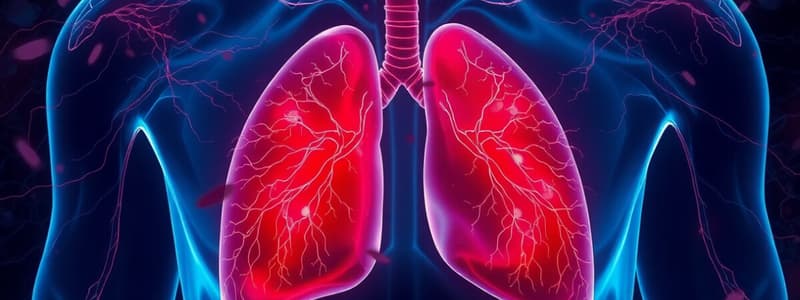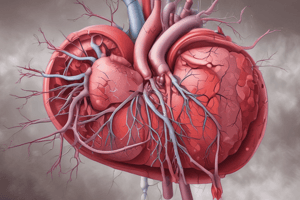Podcast
Questions and Answers
What is the definition of pulmonary embolism?
What is the definition of pulmonary embolism?
Obstruction of part of, or the entire pulmonary vascular tree, usually caused by thrombus from a distant site.
What is the most common source of thrombus that leads to pulmonary embolism?
What is the most common source of thrombus that leads to pulmonary embolism?
- From the lungs
- From the lower limbs and pelvis (correct)
- From the heart
- From the upper limbs
Paradoxical emboli should not be considered as a cause for a stroke in the young.
Paradoxical emboli should not be considered as a cause for a stroke in the young.
False (B)
What hemodynamic effect does a large clot have in pulmonary embolism?
What hemodynamic effect does a large clot have in pulmonary embolism?
What usually does not increase until 50% of the vascular bed is occluded in pulmonary embolism?
What usually does not increase until 50% of the vascular bed is occluded in pulmonary embolism?
Risk factors for venous thromboembolism include major abdominal or pelvic surgery and _____ surgery.
Risk factors for venous thromboembolism include major abdominal or pelvic surgery and _____ surgery.
Which of the following is a risk factor for venous thromboembolism?
Which of the following is a risk factor for venous thromboembolism?
Flashcards are hidden until you start studying
Study Notes
Pulmonary Embolism
- Pulmonary embolism (PE) occurs when part or all of the pulmonary vascular tree is obstructed, typically due to a thrombus from a distant site.
- The deep venous system of the lower limbs and pelvis accounts for 75% of PE cases.
- Leg thrombi are more likely to embolize from above-the-knee clots (20% incidence) compared to below-the-knee clots.
- Paradoxical emboli can cause strokes in young individuals.
- Septic emboli may arise in endocarditis, especially with intraventricular septal defects or AV shunts.
Hemodynamic Effects
- The impact of PE on hemodynamics is influenced by:
- The size of the clot,
- The specific area of the pulmonary vascular tree obstructed,
- The pre-existing condition of the myocardium.
- Large clots often lodge at the bifurcation of main pulmonary arteries, causing hemodynamic compromise.
- Small clots may travel distally, leading to infarction in regions where blood flow is greatest (commonly lower lobes).
- Mean pulmonary arterial pressure (PAP) does not increase until at least 50% of the vascular bed is occluded.
- Right ventricle (RV) failure may occur when PAP exceeds 40 mmHg, particularly in patients with pre-existing cardiopulmonary disease.
- Associated cardiovascular effects include V/Q mismatch and bronchospasm.
- Respiratory effects may consist of alveolar collapse, pulmonary edema, and systemic hypoxemia.
Resolution and Etiology
- Peripheral pulmonary infarction is more common than central.
- Resolution of PE can take days to weeks through fibrinolysis, requiring the absence of recurrence.
- The etiology of PE involves the activation of the clotting cascade due to:
- Venous stasis,
- Injury to the vessel wall,
- Increased blood coagulability, leading to thrombus formation.
- Venous stasis can be exacerbated by immobility and dehydration, with alterations in coagulation factors seen in acute phase responses, malignancies, and autoimmune diseases.
Risk Factors for Venous Thromboembolism
- Major risk factors include:
- Extensive abdominal or pelvic surgeries,
- Orthopedic surgeries, particularly those involving the lower limbs,
- Post-operative intensive care unit stays,
- Pregnancy, especially with multiple births and cesarean sections, and conditions like pre-eclampsia.
Studying That Suits You
Use AI to generate personalized quizzes and flashcards to suit your learning preferences.





